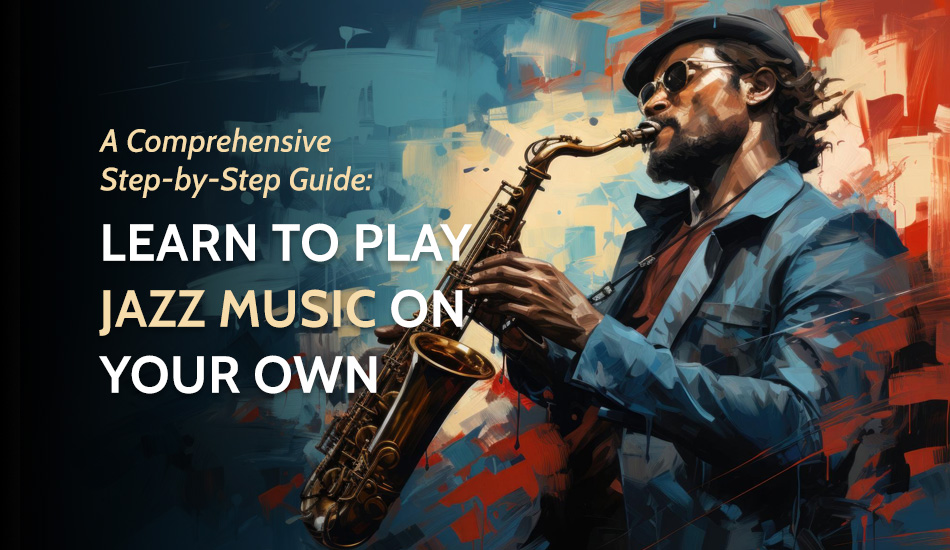While learning how to play jazz music alone may be quite challenging, it is definitely very possible with the right approach. This often leads to the argument that only those who attended music schools or academies and those who were guided personally by bandleaders may master jazz. Nevertheless, these tracks can be very helpful, and there are more ways to become a talented jazz musician. Jazz can be learned at home as long as it is done with dedication, with a structure, and with the right instruments. In the following guide, we do step through the basics, detailing a method that can guide you in beginning to learn to play jazz, including listening habits, finding other musicians to practice with, etc.
Step 1: Start Listening to Jazz Like It’s Your Job
The only way that one can truly understand and be able to play jazz is by fully experiencing it. Listening is the key to jazz education because it teaches one how to listen to the sounds being played and easily distinguish intricate rhythms, melodies, and harmony.
- Listen Actively: Do not listen to jazz as background music while you engage in other activities. One can use the time actively to listen properly. Paying attention to parts of the music, like improvisation, swing, syncopation, and intricate rhythms. Focus on how the various instruments support each other and how solos are built up.
- Explore Various Styles: Jazz is a large category of music, and many subgenres or substyles exist, such as bebop, cool jazz, modal jazz, and avant-garde jazz. Both styles present lessons and difficulties incomparable to each other. If you listen to various kinds of jazz, it is possible to realize that jazz is tremendously different, and you may be inspired by various sources.
- Listen Repeatedly: Repetition is important, and one has to listen to jazz music over and over to understand its subtleties. You can either select a couple of albums or songs that depict your current state and listen to them for days. Every time, try to find something new or notice how the piece is constructed in terms of form.
- Discover Influential Artists: Begin with the legends of jazz, like Miles Davis, John Coltrane, Charlie Parker, and Thelonious Monk. These are artists who have defined and influenced the jazz genre, and if you have a chance to study their work, you will learn how jazz developed.
The more you integrate jazz music into your daily schedule, the more you are going to develop the ability to hum the rhythms, harmonies, and melodies you hear as you practice.
Step 2: Measure Your Current Playing Ability
It is always important to assess the current level of your skill before you go ahead to experiment with the new skills. This self-assessment will therefore assist you in recognizing your strengths and challenges so that you can practice in the best manner.
- Record Yourself Playing: First of all, record yourself while performing several tunes with which you feel rather at ease. This could have been pieces from the classical repertoire or even just scales, to jazz standards. Recording enables you to hear what you are playing, and this can be very hard to do when playing the instrument.
- Critical Listening: After recording, make sure you listen back to it and jot down several points you noted about your performance. Ask yourself the following questions:
- How is my timing? Is the rhythm stable, rapid or slow?
- Are my notes accurate and in tune?
- Is my rhythm precise and intentional?
- How is my articulation? Is it crisp and clear or muddy?
- Did I create sufficient contrast in dynamics and phrasing?
- Was my improvisation creative and coherent?
- Identify Areas for Improvement: From your notes, make a list of the areas of concern. We tend to lie to ourselves too much; admitting that we are wrong is half the battle won.
- Set Goals: Set measurable targets for every practice session so that improvement can be measured against those targets for that particular day. It can be to get better at timing, practicing a new scale, working on articulation, or something else; however, goals are important to keep you on track.
This self-assessment is in fact not a one time exercise; it is suggested to go back to it from time to time and see the advancements made and then modify the practice schedule accordingly.
Step 3: Identify Your Most Inspiring Recording Artists
We can also deduce that inspiration is also a very big factor in the learning process of a student. It is always good to see what the other jazz music artists are doing as far as music production is concerned; this will give you ideas that you would like to implement.
- Create a List of Influential Artists: Some of the jazz musicians you may like most include: Which artists make you say to yourself, ‘I want to play like this’? Come up with at least five to six artists’ labels. It can be a list of Jazz greats from the older generation like Duke Ellington, Herbie Hancock and a list of contemporary modern day Jazz maestros including Kamasi Washington.
- Deep Dive into Their Work: Spend time listening to the recordings of these artists. Paying attention to details of involved aspects such as the phrasing of sounds, rhythm, articulation and the kind of improvisation that is exercised. Observe how they perform different songs, and how their manner changed in time.
- Analyze Their Techniques: It is also helpful to attempt to find out what makes the technique of each of the artists unique. That is, you might analyze the sheets of sound in John Coltrane, the voicings of Bill Evans or the rhythmical fantasy of Art Blakey. That will let you understand what kind of techniques you should pay your attention to in the course of your practice.
- Broaden Your Horizons: It is always good to have favorite artists but occasionally, it is advisable to look further. Another way is to attend jazz playlists which offer listeners a chance to check out new unknown artists, as well as jazz radio stations and streaming platforms. And often, you will stumble upon inspiration where it is least expected.
Thus, locating and analyzing the work of the musicians you like the most allows one to refine the vision of techniques and styles which one wishes to utilize in his/ her performances.
Step 4: Map Out Jazz Techniques/Theory You’d Like to Learn
Having a selected set of artists and styles, you need to choose the precise methods you want to employ and the theories that you would like to follow.
- Choose Key Techniques: Out of your chosen inspiring artists, identify certain techniques that appeal to you. This could be anything from a certain way of phrasing, a voicing, a rhythm, or an approach to improvisation. For example, you might want to learn to play like singing jazz vocalists who scat sing or how to apply chord substitutions while soloing.
- Study Jazz Theory: Jazz is deeply rooted in theory, including scales, chord progressions, modes, and improvisational techniques. Make sure to study these elements thoroughly. Understanding the theory behind the music will help you make sense of what you’re playing and enable you to be more creative.
- Break Down Complex Concepts: There are some aspects that pertain to jazz music that can be a bit tricky to grasp and, as such, should be divided into easy segments. For instance, when learning about modal jazz, begin by mastering one mode at a time. Use that mode to practice improvising over the different chord changes before progressing to the next one.
- Create a Practice Plan: With your mind on the techniques and theoretical concepts selected below, create a structured practice plan. Schedule how many hours you will spend on a particular area and set realistic expectations for what you wish to achieve in the short run.
Knowing the specific skill and theory that concern the ability to meet your interest will dictate your practice sessions and guarantee that you perform more in less time.
Step 5: Practice Your Selected Technique/Theory in Isolation
It is now time to form practice isolation of the techniques and the theory that you want to study. A little practice will do it this focused way will let you gain more confidence and skill and then use them in complete pieces.
- Design Targeted Exercises: Design exercises that are directed towards the techniques or theory you wish to master. For instance, if you are practicing chord voicings, create an exercise that will help you do the chord voicings in all twelve keys. If you are working on rhythm, ensure that you play some of the given rhythms at different speeds.
- Start Slow and Build Up: Begin your practice at a slow tempo to ensure accuracy and control. As you become more comfortable, gradually increase the speed. This methodical approach helps prevent the development of bad habits and ensures that you’re truly internalizing the techniques.
- Use a Metronome and Backing Tracks: A metronome is essential for developing good timing, while backing tracks help you practice in a more musical context. Use both tools to enhance your practice sessions. For example, you might practice soloing over a backing track while focusing on a specific scale or chord progression.
- Be Consistent: It takes time and practice to master a new technique. But make sure that you practice from time to time no matter how little time it may be. It means that in order to achieve any change, it is necessary to be constant.
- Evaluate and Adjust: Record yourself once in a while in order to check how you are developing. Reflectively listen back and assess the requirements for modifying the practice routine accordingly. If a particular technique is not effective, then slow down and go back to square one.
A lot of practice can be done in isolation, this will make it easy to develop each of these techniques and use them in regular playing.
Step 6: Start Finding Other Jazz Musicians to Play With
Jazz is by its nature an ensemble music and playing with other musicians is part of the learning process. It also enables you to get a taste of the timing, interaction and ability to improvise during a live performance.
- Join Local Jazz Groups: Check the local jazz bands, groups, jam sessions and ensembles that you can be part of. Practicing with other people will help conquer the comfort zone that is necessary to receive new ideas and improve one’s style. It can also serve as a useful means of contacting other musicians and getting a sense of what they have been through.
- Collaborate Online: If local opportunities are limited, consider collaborating with other musicians online. Platforms like YouTube, Instagram, or Facebook are great places to connect with jazz enthusiasts. You can exchange ideas, participate in virtual jam sessions, or even collaborate on projects remotely.
- Learn from Your Peers: Performing in sessions with other musicians means you get to learn in real-time. Focus on how they play solos, rhythm and how they perform as two individuals. Do not be afraid to go back to them and request their opinion or advice, they may have some things that you never would have thought of on your own.
- Challenge Yourself: As you perform with others, attempt to go out of your comfort zone. Choose to play with musicians who are better than you so that you can be forced out of your comfort zone. This may sound scary, but it is one of the most effective ways to learn.
Record Your Sessions: Always record your jam sessions or group practice if you have the ability to do so. Playback of such recordings will assist you in finding your weak areas and also the way you relate to other musicians.
Playing with other people is one of the best parts and benefits of studying jazz music. It will help you improve your musicianship, your talent to improvise, and your confidence.
Step 7: Find Resources to Study With
Even if you are serious about self-study, there are numerous resources that can be used to complement your learning and give the studying regimen some sort of framework.
- Books and Method Guides: Buy a couple of good jazz methods or theory books in case the jazz experience is needed. The book of Levine “The Jazz Theory Book” and David Baker’s “Jazz Improvisation” are a few good examples of books that guide through the boundaries of jazz theory and performance.
- Online Courses and Tutorials: Also consider such courses that are available in the online platform and are special for jazz musicians. Today, services such as Udemy, Coursera or MasterClass have courses provided by professional jazz musicians. These courses may consist of videos, practices, and feedback sections, which, if encouraged, can help you a lot.
- Seek Guidance from Experienced Musicians: If an opportunity presents itself, take a lesson or two from a professional jazz singer or musician. Even if you partially or fully teach yourself, occasional lessons can be very helpful and give a hint about certain difficulties.
- Jazz Communities and Forums: Read the blogs of other jazz lovers and join online groups and forums where people share their jazz experience, knowledge, tips, and useful information. It can also provide you with a range of information when you participate in these communities, and it can also motivate you.
- Study the Classics: Even when you are thinking about the future, do not neglect the past. Just picking several best jazz songs recorded throughout the years and listening to and analyzing them can be a great learning experience. Memorize the solos, notate the melodies, and, to a certain extent, attempt to understand why that musician played that way.
Utilizing a variety of resources will help you build a well-rounded understanding of jazz music and keep your practice sessions engaging and effective.
Conclusion
Teaching yourself jazz music is a journey filled with discovery, challenges, and immense rewards. By immersing yourself in the genre, evaluating your skills, studying inspiring artists, practicing techniques, playing with others, and using supplementary resources, you can develop a solid foundation in jazz. Remember, learning jazz is a lifelong process, and each step you take brings you closer to mastering this incredible art form. Embrace the journey, keep exploring, and most importantly, enjoy the music.
For more insights into jazz music and to explore some of the jazz songs and jazz singers, be sure to check out additional resources and recordings. Your path to jazz mastery is just beginning—take it one note at a time.




